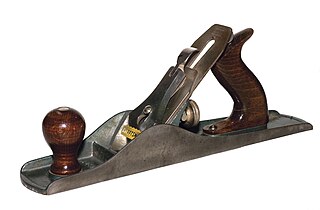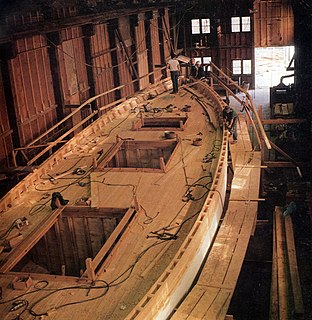
A hull is the watertight body of a ship, boat, or flying boat. The hull may open at the top, or it may be fully or partially covered with a deck. Atop the deck may be a deckhouse and other superstructures, such as a funnel, derrick, or mast. The line where the hull meets the water surface is called the waterline.

Longships were a type of specialised Scandinavian warships that have a long history in Scandinavia, with their existence being archaeologically proven and documented from at least the fourth century BC. Originally invented and used by the Norsemen for commerce, exploration, and warfare during the Viking Age, many of the longship's characteristics were adopted by other cultures, like Anglo-Saxons, and continued to influence shipbuilding for centuries.

A dory is a small, shallow-draft boat, about 5 to 7 metres or 16 to 23 feet long. It is usually a lightweight boat with high sides, a flat bottom and sharp bows. They are easy to build because of their simple lines. For centuries, dories have been used as traditional fishing boats, both in coastal waters and in the open sea.

An adze is an ancient and versatile cutting tool similar to an axe but with the cutting edge perpendicular to the handle rather than parallel. They have been used since the Stone Age. Adzes are used for smoothing or carving wood in hand woodworking, and as a hoe for agriculture and horticulture. Two basic forms of an adze are the hand adze —a short handled tool swung with one hand— and the foot adze (hoe) —a long handled tool capable of powerful swings using both hands, the cutting edge usually striking at foot or shin level. A similar tool is called a mattock, which differs by having two blades, one perpendicular to the handle and one parallel.

A hand plane is a tool for shaping wood using muscle power to force the cutting blade over the wood surface. Some rotary power planers are motorized power tools used for the same types of larger tasks, but are unsuitable for fine-scale planing, where a miniature hand plane is used.

Boat building is the design and construction of boats and their systems. This includes at a minimum a hull, with propulsion, mechanical, navigation, safety and other systems as a craft requires.

Sail components include the features that define a sail's shape and function, plus its constituent parts from which it is manufactured. A sail may be classified in a variety of ways, including by its orientation to the vessel and its shape,. Sails are typically constructed out of flexible material that is shaped by various means, while in use, to offer an appropriate airfoil, according to the strength and apparent direction of the wind. A variety of features and fittings allow the sail to be attached to lines and spars.

Clinker built is a method of boat building where the edges of hull planks overlap each other. Where necessary in larger craft, shorter planks can be joined end to end into a longer strake or hull plank. The technique developed in northern Europe and was successfully used by the Anglo-Saxons, Frisians, Scandinavians, and typical for the Hanseatic cog. A contrasting method, where plank edges are butted smoothly seam to seam, is known as carvel construction.

Turning is a machining process in which a cutting tool, typically a non-rotary tool bit, describes a helix toolpath by moving more or less linearly while the workpiece rotates.
A spile is a small wooden or metal peg used to control the flow of air into, and carbon dioxide out of, a cask of ale. Spiles can also be used to broach water from trees.

A lath or slat is a thin, narrow strip of straight-grained wood used under roof shingles or tiles, on lath and plaster walls and ceilings to hold plaster, and in lattice and trellis work.
A chine in boat design is a sharp change in angle in the cross section of a hull. The chine typically arises from the use of sheet materials as the mode of construction.
This glossary of woodworking lists a number of specialized terms and concepts used in woodworking, carpentry, and related disciplines.

The Chesapeake Bay deadrise or deadrise workboat is a type of traditional fishing boat used in the Chesapeake Bay. Watermen use these boats year round for everything from crabbing and oystering to catching fish or eels.

A sailing yacht, is a leisure craft that uses sails as its primary means of propulsion. A yacht may be a sail or power vessel used for pleasure, cruising, or racing. There is no standard definition, so the term applies here to sailing vessels that have a cabin with amenities that accommodate overnight use. To be termed a "yacht", as opposed to a "boat", such a vessel is likely to be at least 33 feet (10 m) in length and have been judged to have good aesthetic qualities. Sailboats that do not accommodate overnight use or are smaller than 30 feet (9.1 m) are not universally called yachts. Sailing yachts in excess of 130 feet (40 m) are generally considered to be superyachts.
Lofting is a drafting technique whereby curved lines are generated, to be used in plans for streamlined objects such as aircraft and boats. The lines may be drawn on wood and the wood then cut for advanced woodworking. The technique can be as simple as bending a flexible object, such as a long strip of thin wood or thin plastic so that it passes over three non-linear points, and scribing the resultant curved line; or as elaborate as plotting the line using computers or mathematical tables.

Steam bending is a woodworking technique where wood is exposed to steam to make it pliable. Heat and moisture from steam can soften wood fibres enough so they can be bent and stretched, and when cooled down they will hold their new shape.

A steam box is a long, sealed container used to steam wooden planks for the purpose of making them pliable. Once steamed and then fastened or clamped into the desired position and left to dry, the wood will hold the new shape. Steam boxes allow for much more efficient use of wood. Instead of cutting the desired shape away from a large and more expensive piece of wood and leaving much scrap to be discarded, steam boxes allow for a smaller piece to be bent in the general shape and leaving much less scrap. Steam boxes also allow the wood to bend beyond its dry breaking point, which is useful in making extreme curves with the wood. In many cases, the bent piece is stronger than an identical piece cut from larger stock. Steam bending wood allows the wood grain to follow the bend, leaving it strong where a piece cut from larger stock would snap across crosscut grains or laminated joints.

The Abydos boats are the remnants of a group of ancient royal Egyptian ceremonial boats found at an archaeological site in Abydos, Egypt.
The circular arc hull is a design for boat hulls created by Swedish engineer Fredrik Ljungström. In the 1930s and 1940s Ljungström designed and built sailboats, commonly called the Ljungström sailboat.



















